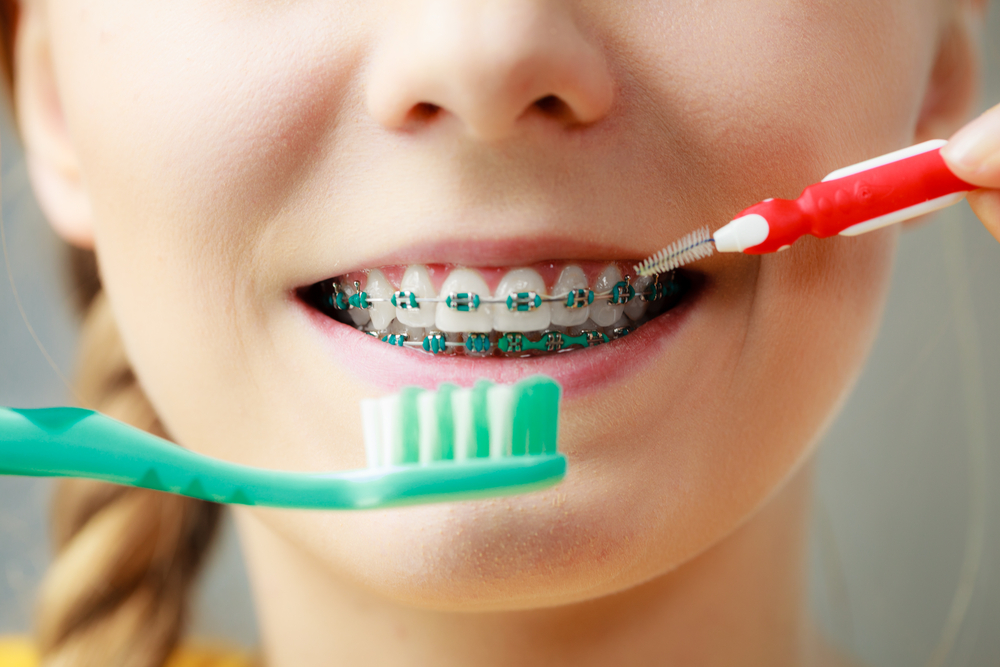
Getting braces is exciting and means your child or teenager is on their way to a straighter, healthier smile. It also means that brushing and flossing will be a little more challenging and plaque will have extra places to hide. Well, Kids Mile High Pediatric Dentistry is here to help! We’re sharing our best oral hygiene tips to ensure your child’s smile is as healthy and dazzling as possible when those braces come off.
The Consequences of Poor Oral Hygiene With Braces
While having poor oral hygiene any time can lead to cavities, having bad hygiene with braces really increases the risk of tooth decay and gingivitis. As we said, braces tend to trap food, bacteria and plaque. Good hygiene is essential because teeth move most effectively in a healthy oral environment. Additionally, in extreme cases, getting cavities with braces could mean having to have the braces taken off, so the decay can be treated.
How to Have Good Oral Hygiene With Braces
Now that we’ve discussed the consequences of poor oral hygiene with braces, the good news is, kids and teens can keep their teeth healthy during their orthodontic treatment with a few easy steps. Though flossing and brushing teeth with braces will require learning some new techniques, once kids get used to the process, it will become second nature.
Here are our 8 best oral hygiene tips for kids to get your child get started:
- Learn How to Brush Teeth With Braces and Do it Often.
With braces, your child will want to brush their teeth in the morning, after meals and snacks, and before bed. Yup, that’s a few more daily brushing sessions than usual.
As for how to brush your teeth with braces, use a soft-bristled toothbrush or an electric toothbrush and the toothpaste of your choice (the best toothpaste for braces is one that doesn’t contain whitening ingredients, as these can increase sensitivity and lead to uneven results).
Hold the toothbrush at a 45-degree angle. Start by gently brushing along the gum line. Then, brush every bracket, working on the top and bottom of the bracket separately. Wiggling the bristles back and forth a bit will help get between the wires. Give each individual tooth some attention and brush all of the surfaces of the teeth, including around those back molars. Be sure your child brushes for at least two full minutes.
- Floss Once Daily.
Flossing with braces will be tricky at first because kids have to get under the wires in order to clean between their teeth. However, most patients acclimate quickly. While you can use regular dental floss on its own, the process will be much easier if your child or teen uses a floss threader.
Or, to save even more time, they can use special floss for braces, such as an orthodontic flosser or a product like SuperFloss. Regardless of what type of floss they opt for, flossing at least once daily is key.
- How to Floss With Braces Using a Floss Threader – To floss with braces using a floss threader, first, break off a piece of dental floss about 18 to 24 inches in length. (Pro tip: Use waxed dental floss because braces will shred unwaxed floss.) Pull some of the floss through the eye of the floss threader. Pinch it so that it doesn’t slide out.
Guide the pointed end of the floss threader under the braces wire and pull the floss through until it can be gripped with both hands. Position the floss between any two teeth. Floss up and down the side of one tooth, getting under the gumline, and then up and down the side of the other tooth.
Gently pull the floss out. Use the floss threader to get under the wire and in between the next set of teeth. Repeat this until the entire mouth has been flossed.
When flossing with Super Floss, the process will be the same. However, kids won’t need to thread the floss through the end since it’s already set up. They’ll simply guide the stiffened end under the braces wire and go through the same steps as above.
- How to Floss With Braces Using an Orthodontic Flosser – While an orthodontic flosser, which is a special floss pick for braces wearers, is a little more expensive, it’s a whole lot faster. To floss with an orthodontic flosser, slip the rounded end of the flosser under the braces wire so the floss is positioned in between two of the teeth. Floss up and down the side of one tooth, getting just under the gum line, and then floss up and down the side of the other tooth. Repeat until all of the teeth have been flossed.
- Consider Investing in a Waterpik for Braces.
A Waterpik, or water flosser, sprays water in between the teeth, around the gums and around the braces brackets. While using a Waterpik for braces won’t replace regular flossing and will be an extra step, it’s an excellent tool for loosening stubborn food, getting the gums super clean and eliminating any lingering plaque. Most of our Denver braces patients are big fans.
If your child or teen does opt to use a water flosser for braces, go with an orthodontic tip. Have them use the water flosser before or after flossing the teeth with dental floss.
- Use an Interproximal Brush to Clean Tight Spaces.
An interproximal brush, sometimes called a proxy brush or interdental brush, is a tiny brush meant to squeeze into tight spaces. Kids can use it to clean around their braces brackets and to remove any plaque or debris their toothbrush can’t reach. It’s also incredibly handy for dislodging food stuck in braces.
- Add Mouthwash to the Mix.
Swishing with mouthwash after flossing and brushing can help to loosen any trapped bits of food and get into those hard-to-reach places. What’s the best mouthwash for braces? Any alcohol-free, fluoride mouthwash or, if you’d prefer to skip fluoride, one that contains xylitol, will do the trick and help fight cavities. ACT Anticavity Mouthwash and Colgate Phos-Flur Ortho Defense Anticavity Mouth Rinse are both excellent options and usually top any list of the best mouthwash for braces.
- Put Together a Braces Hygiene Kit for When Kids are Out and About.
Since brushing teeth with braces is recommended after meals and snacks, kids and teens will likely have to brush when they’re at school, at friends’ houses, etc. Make a travel kit that they can bring with them wherever they go. Your hygiene kit should include:
- A travel toothbrush
- Travel toothpaste
- Interproximal brushes
- Orthodontic flossers
- Braces wax (while wax isn’t really hygiene-related, it will help with any irritation or braces emergencies)
- No Toothbrush Around? Rinse Really Well!
If kids or teens aren’t home and don’t have their toothbrush, they should rinse their mouth out really well with water after eating or drinking. This will whisk away some of the food debris and liquids so they don’t sit on the teeth for a prolonged period of time. Then, have kids brush their teeth as soon as they’re reunited with their toothbrush.
- Keep Up With Regular Pediatric Dental Visits.
Regular exams and cleanings at the dentist are more important than ever when kids are in braces treatment. During professional cleanings, special tools are used to remove hardened plaque (tartar) that can’t be eliminated at home with a regular toothbrush and floss.
Dr. Paddy, Dr. Roger or Dr. Meredith will also be able to ensure your child’s mouth is healthy and cavity-free. If they spot an issue, intervening early will ensure your child’s braces treatment stays on track. During the exam, they can see how well your child is doing with their oral hygiene routine, too. Extra cleanings might be recommended throughout the year if hygiene is a problem.
By putting our oral hygiene tips into action and caring for their braces and smile, your child will get the outstanding results they deserve. Whether you’d like to learn more about braces for kids and teens, or you’re looking for a fun, friendly pediatric dentist, we’ve got you covered. Schedule a visit at Kids Mile High Pediatric Dentistry in Thornton, Denver or Englewood, CO today!



